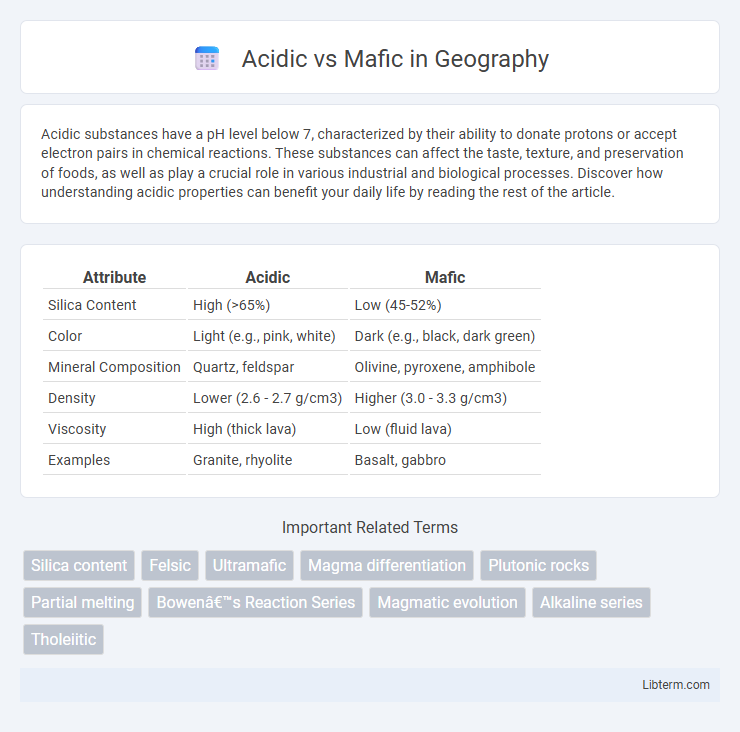Acidic substances have a pH level below 7, characterized by their ability to donate protons or accept electron pairs in chemical reactions. These substances can affect the taste, texture, and preservation of foods, as well as play a crucial role in various industrial and biological processes. Discover how understanding acidic properties can benefit your daily life by reading the rest of the article.
Table of Comparison
| Attribute | Acidic | Mafic |
|---|---|---|
| Silica Content | High (>65%) | Low (45-52%) |
| Color | Light (e.g., pink, white) | Dark (e.g., black, dark green) |
| Mineral Composition | Quartz, feldspar | Olivine, pyroxene, amphibole |
| Density | Lower (2.6 - 2.7 g/cm3) | Higher (3.0 - 3.3 g/cm3) |
| Viscosity | High (thick lava) | Low (fluid lava) |
| Examples | Granite, rhyolite | Basalt, gabbro |
Introduction to Acidic and Mafic Rocks
Acidic and mafic rocks are classified based on their silica content, with acidic rocks containing more than 63% silica and mafic rocks having 45-52% silica. Acidic rocks like granite are rich in quartz and feldspar, resulting in lighter colors and lower density, whereas mafic rocks such as basalt and gabbro are abundant in magnesium and iron minerals, giving them darker colors and higher density. These compositional differences influence the rocks' physical properties, formation processes, and geological significance.
Defining Acidic Rocks
Acidic rocks are igneous rocks with high silica content, typically above 63%, resulting in lighter colors and higher viscosity magma. Common examples include granite and rhyolite, characterized by abundant quartz and feldspar minerals. Their high silica content influences their mineral composition, melting point, and eruption style compared to mafic rocks, which contain lower silica and higher iron and magnesium.
Defining Mafic Rocks
Mafic rocks are igneous rocks characterized by high concentrations of magnesium and iron, giving them a darker color and higher density compared to acidic rocks. These rocks typically include basalt and gabbro, which form from magma rich in mafic minerals like pyroxene and olivine. The mineral composition distinguishes mafic rocks from acidic rocks, which contain higher silica content and lighter minerals such as quartz and feldspar.
Chemical Composition Comparison
Acidic rocks contain high silica content, typically over 63%, primarily composed of quartz and feldspar minerals, which results in lighter color and lower density. Mafic rocks have lower silica content, ranging between 45-52%, and are rich in magnesium and iron-bearing minerals like pyroxene and olivine, giving them a darker color and higher density. This distinct chemical composition directly influences their physical properties and classification in igneous petrology.
Color and Texture Differences
Acidic igneous rocks, such as granite, typically exhibit light colors including white, pink, or light gray due to high silica content, while mafic rocks like basalt are darker, often black or dark green, due to higher magnesium and iron content. Texturally, acidic rocks tend to have coarse-grained crystals visible to the naked eye, indicating slower cooling beneath the Earth's surface, whereas mafic rocks usually have fine-grained or glassy textures resulting from rapid cooling. These color and texture differences reflect the distinct mineral compositions and cooling histories characteristic of acidic and mafic rock types.
Formation Processes
Acidic rocks form from magma rich in silica, typically over 65%, leading to viscous lava that cools slowly and creates fine-grained textures. Mafic rocks originate from magma with lower silica content, around 45-52%, and higher levels of magnesium and iron, resulting in less viscous lava that solidifies rapidly. The contrasting cooling rates and chemical compositions of acidic versus mafic magmas produce distinctive mineral assemblages and rock structures.
Occurrence and Distribution
Acidic rocks, rich in silica and primarily composed of quartz and feldspar, predominantly occur in continental crust regions such as mountain belts and shield areas, where tectonic activity promotes their formation. Mafic rocks, characterized by higher magnesium and iron content and lower silica, are commonly found in oceanic crust and volcanic island arcs, reflecting their association with mantle-derived magmas. The global distribution of acidic rocks is concentrated in stable continental interiors and convergent plate boundaries, whereas mafic rocks dominate mid-ocean ridges and hotspot volcanic regions.
Economic and Industrial Uses
Acidic rocks, such as granite, are rich in silica and commonly used in construction, decorative stone, and as aggregate in concrete production due to their durability and aesthetic appeal. Mafic rocks like basalt contain higher iron, magnesium, and calcium, making them valuable as raw materials in the production of cement, road base materials, and as sources of industrial minerals such as olivine used in refractory applications. The economic importance of mafic rocks extends to mining operations for metals like nickel, chromium, and platinum-group elements found within ultramafic complexes, driving key industrial sectors.
Geological Significance
Acidic rocks, rich in silica such as granite, indicate continental crust formation processes and often associate with mountain-building events due to their high viscosity magma. Mafic rocks, like basalt and gabbro, contain lower silica content and are crucial for understanding oceanic crust formation and mantle-derived magmas, highlighting tectonic settings like mid-ocean ridges and volcanic island arcs. The contrasting mineral compositions and eruption styles between acidic and mafic rocks enable geologists to interpret Earth's crustal evolution and plate tectonic dynamics.
Summary: Key Differences and Similarities
Acidic rocks, such as granite, are rich in silica (over 63%) and light-colored minerals like quartz and feldspar, while mafic rocks like basalt contain lower silica (45-52%) and higher amounts of magnesium and iron, giving them a darker appearance. Both rock types form from the cooling of magma but differ in their mineral composition, density, and melting points, impacting their behavior in geological processes. Despite these differences, acidic and mafic rocks contribute to the diversity of Earth's crust and are essential in understanding volcanic activity and plate tectonics.
Acidic Infographic

 libterm.com
libterm.com